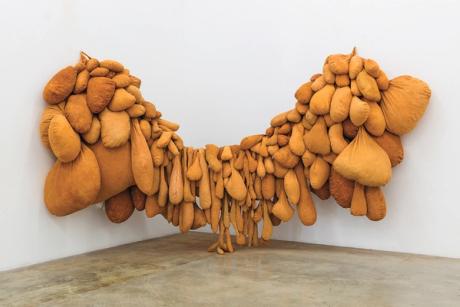Juan III (Pescadores En Una Isla)
2018 - Installation (Installation)
170 x 380 cm
Andrés Pereira Paz
Juan III (Pescadores En Una Isla) is a series of embroideries made with fake pre-Columbian fabrics produced by the Gonzales family, a three-generation family of pre-Columbian textile “forgers” based in Lima, Peru. The members of this family (grandfather, father, and son) all bear the name of Juan and make replicas by hand using traditional methods nearly indistinguishable from the pieces made thousands of years ago. A forgery pretends to be something it is not, but the Gonzalez family’s textiles openly intend to recreate those discovered in the 1920s at a necropolis in Peru. The Paracas Necropolis was heavily looted in the 1930s, and textiles began to appear on the international market within a decade The majority of Paracas textiles in international collections are believed to have been smuggled out of Peru at this time. In the period 200–300 BCE, the necropolis housed 420 mummified bodies wrapped in embroidered textiles. South Americans created these textiles over a thousand years before the Incas. They are brightly colored and depict images of supernatural beings or shamans who use their hands to hold severed human heads while flying like birds. The fabric’s story offers a discussion on trafficking culture, the absence of art-historical scholarship on cultural materials, in particular, the average knowledge of Andean culture before the Inca, and the questionable difference between fakes and forgeries from the real across the Americas. Tourists, collectors, museums wanted the ancient Americas, so locals made the ancient Americas, making fakes a feature of the pre-Columbian antiquities market since there’s been a pre-Columbian antiquities market. One could argue the textiles made by the Gonzales family contribute to preserving and revive the cultural heritage, long history, and soul of Paracas. This series of pieces serve as a tribute to them and this history.
Andrés Pereira Paz’s work regularly takes the form of textiles that explore the circulation of people and materials and how it affects national, regional and global imaginaries, revealing the construction of culture to be an ongoing and often contradictory process. His work examines postcolonial issues from the perspective of the Andean region, particularly from his hometown Bolivia, and from Peru, where the artist recently lived for a few years just before moving to Berlin. The artist frequently references Andean art history, both from the pre-Columbian and colonial periods. He plays with this background and produces creative interpretations of contemporary Andean culture: the results are sometimes humorous, but always witty and incisive. Delving in his work is quite rewarding as his references reach the rich nuances of the region’s cultural history. Paz’s work regularly takes the form of textiles that explore the circulation of people and materials and how it affects national, regional, and global imaginaries, revealing the construction of culture to be an ongoing and often contradictory process.
Colors:
Related works sharing similar palette
» see more

© » SLASH PARIS
Biennale de Lyon — 2024 — Usines Fagor — Exhibition — Slash Paris Login Newsletter Twitter Facebook Biennale de Lyon — 2024 — Usines Fagor — Exhibition — Slash Paris English Français Home Events Artists Venues Magazine Videos Back Biennale de Lyon — 2024 Exhibition Mixed media Upcoming © Biennale de Lyon 2024 Biennale de Lyon 2024 In over 1 year: September 1, 2024 → January 1, 2025 (Dates provisoires) Créée en 1991, la Biennale de Lyon est l’une des plus importantes biennales d’art contemporain au plan international et la première manifestation artistique d’envergure au plan national...
Related works found in the same semantic group
» see more

© » KADIST
Inspired by the series of Mayanist round tables developed by renowned archeologist Merle Greene Robertson (1913—2011), Feathered Changes, Serpent Disappearances: Mesa Redonda brings into discussion some of the enigmatic accounts of excavation and looting that chronicle the dispersal, collection, and preservation of pre-Columbian art and artifacts...

© » KADIST
Jonas Bendiksen
2021For his project Book of Veles artist Jonas Bendiksen travelled to the small city of Veles in North Macedonia, inspired by a series of press reports starting in 2016, that revealed Veles as a major source of the fake news stories flooding Facebook and other social media sites celebrating Donald Trump and denigrating Hillary Clinton...

© » THEARTNEWSPER
A string of new exhibitions shows that textile art is finally being taken seriously Art market Museums & heritage Exhibitions Books Podcasts Columns Technology Adventures with Van Gogh Search Search Comment A string of new exhibitions shows that textile art is finally being taken seriously The historical association of textiles with gender, sexuality and identity norms make them ripe for subversion and reimagining Ben Luke 9 February 2024 Share Solange Pessoa’s Hammock (part of 4 Hammocks , 1999-2003) at the Barbican Courtesy of Rubell Museum, Miami and Washington, DC...




